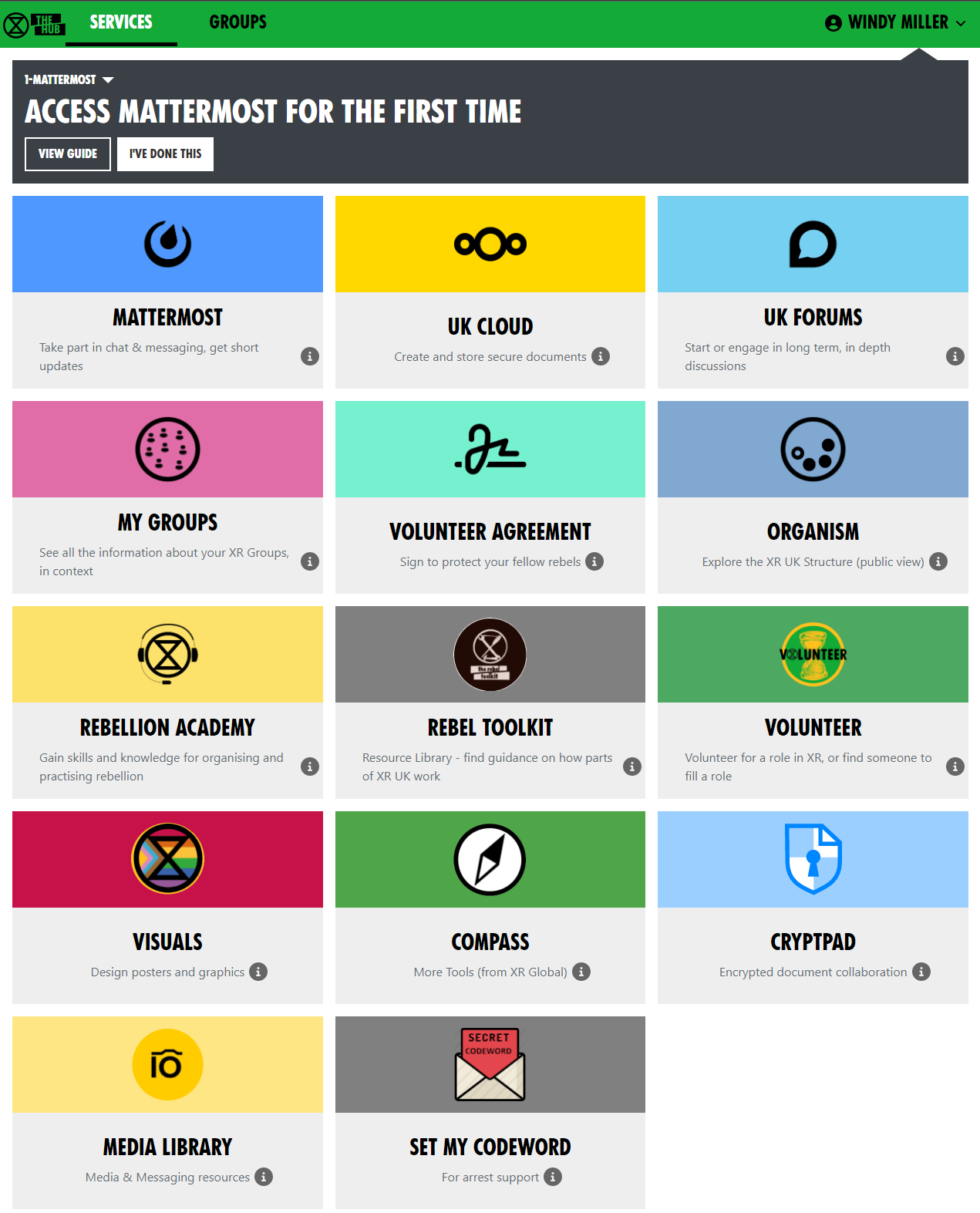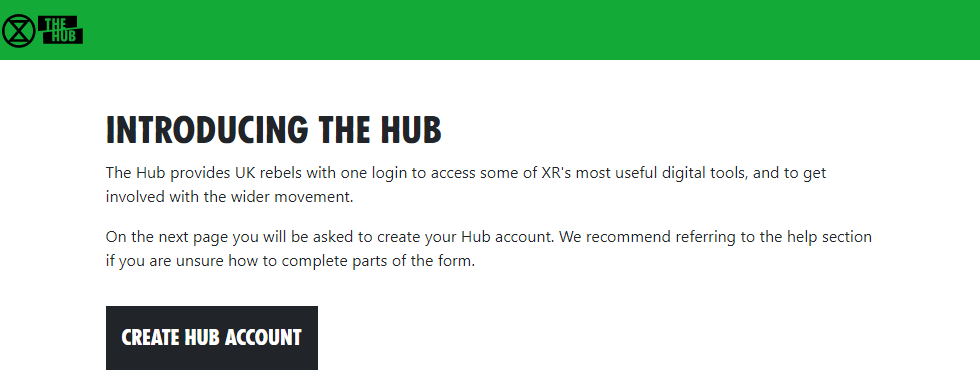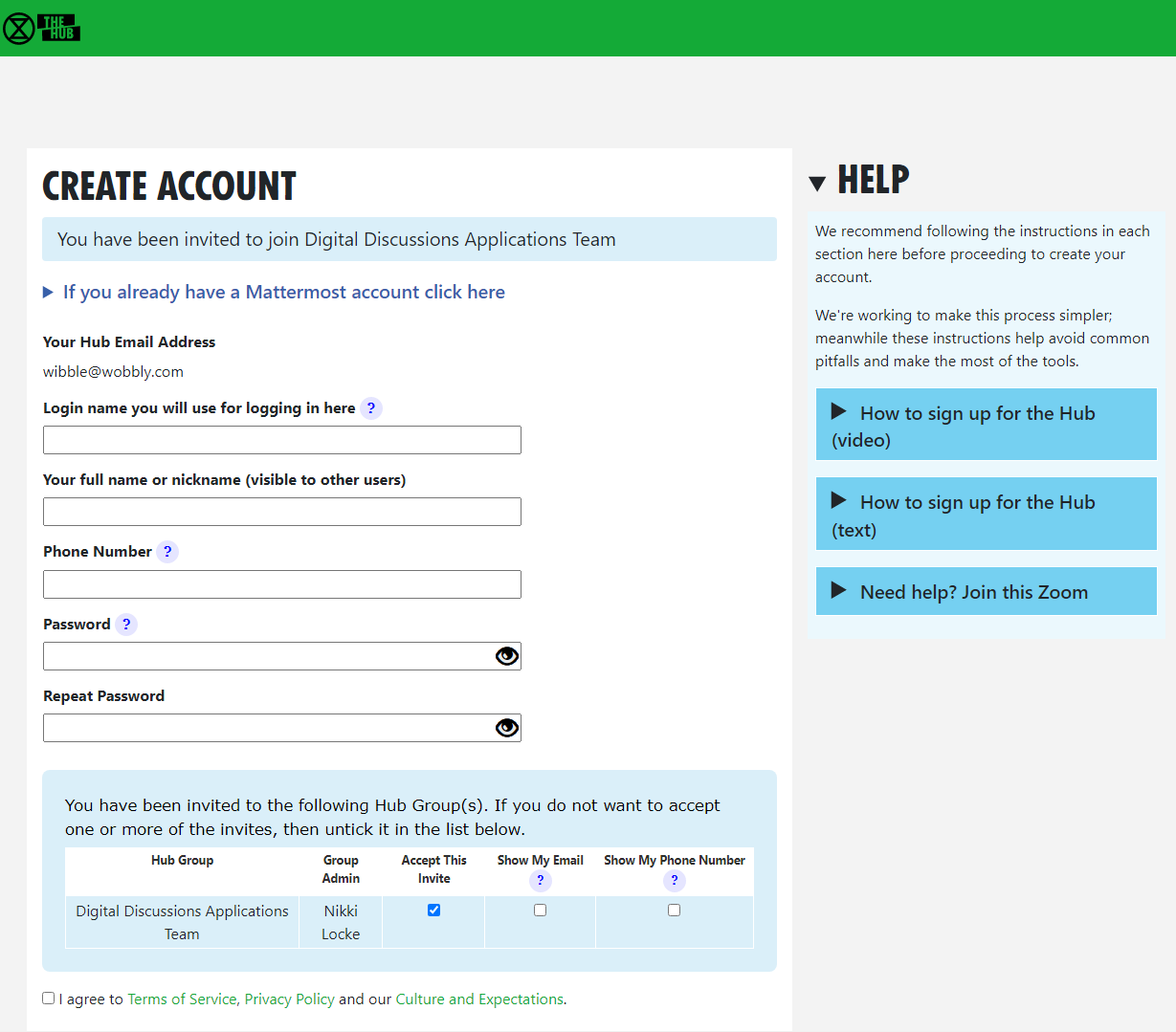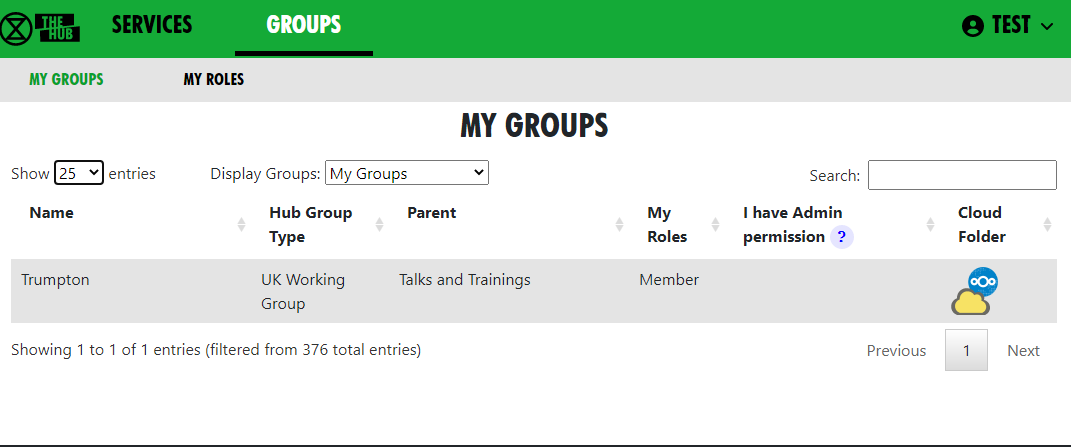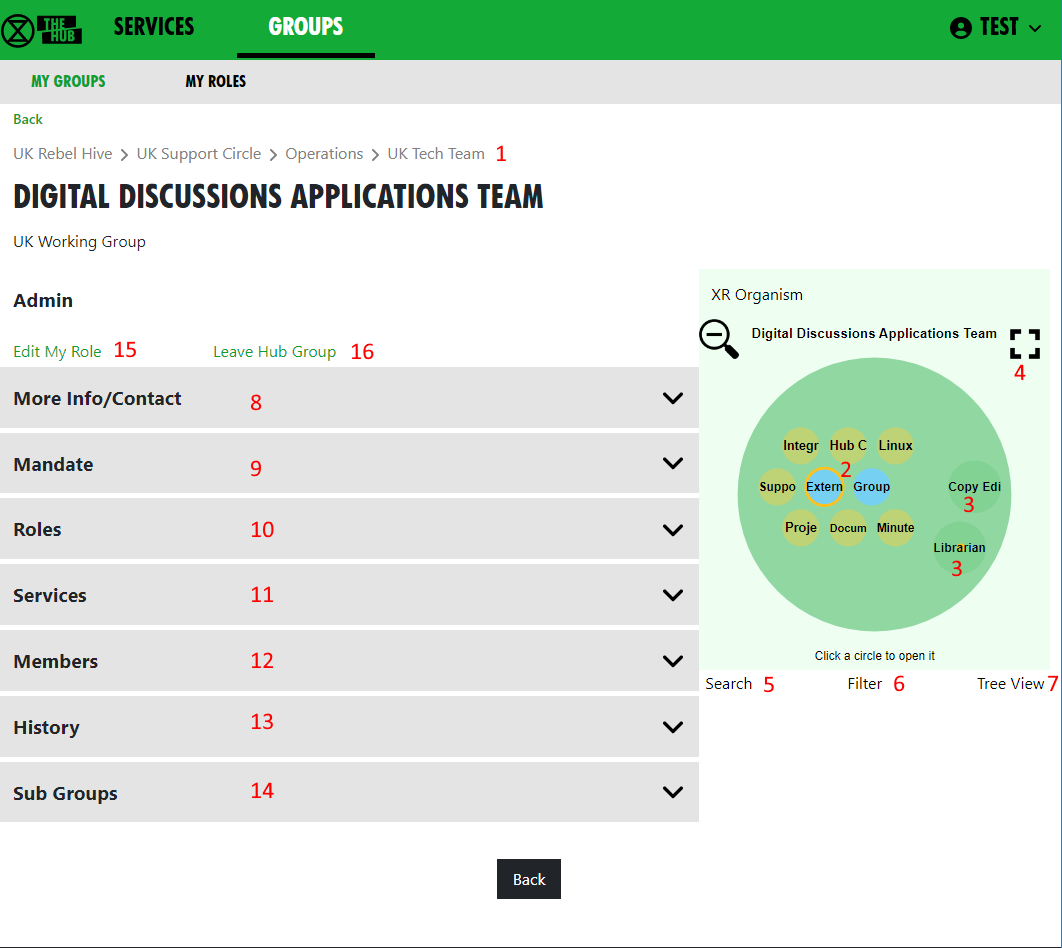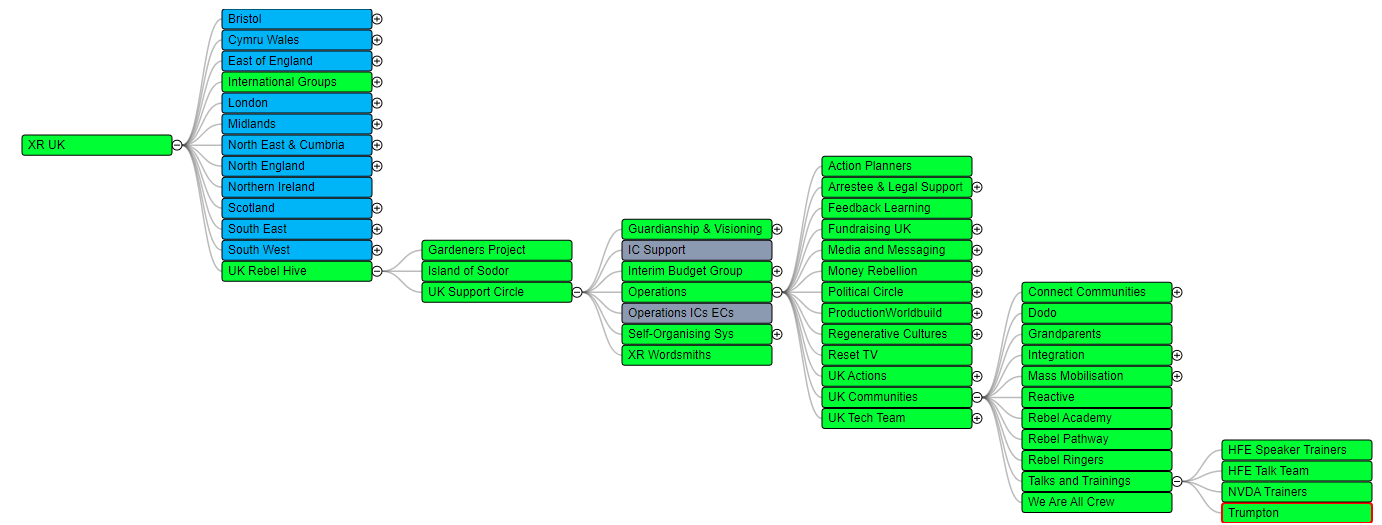The Hub
What is the Hub?
The Hub is the tool XR UK uses to connect lots of the programs (e.g. Mattermost and UK Forums) that rebels use to organise online.
Why do we need it?
The Hub does some really important things:
- It creates accounts for rebels on the other tools (e.g. Mattermost) so you can sign in with the same username and password everywhere.
- It automatically adds rebels to all the channels and forums for all of the XR groups they are a member of.
- It can temporarily suspend the accounts of rebels who are arrested so the authorities cannot get access even if they take the rebel's phone or computer.
The Hub also keeps track of the structure of all the XR groups that have joined (see below). This is extremely useful because it makes it really easy to find the right people to talk to.
How do I join the Hub?
To join the Hub, you need to follow the steps described here.
Using the Hub
Home page
This is the Hub home page. Here you can see links to many other XR services. Click on any of the icons to go to them. Most browsers allow you to click while holding the Ctrl key to open the link in a new tab.
The grey area at the top contains links to training on the XR communication tools. If you already know all about the the subject, click "I'VE DONE THIS" and it will show you the next set of training. Once you have done them all, it will disappear (but you can get it back – there is a link at the very bottom of the page, if you scroll down).
Some of these icons only show if you are logged in to the Hub – click LOG IN toin dothe that:top-right corner:
Admins will have extra options on this page, e.g. to invite other people to the Hub and the new services.
Secret Codeword
Click this icon to set a unique secret codeword to identify you. Then, if you want to communicate with XR (e.g. Arrestee Support) without revealing who you are to anyone listening, you can use the codeword. They can look it up on the Hub, and know who you are.
Only Arrestee Support, Hub Admins, and your Group Admins can see your codeword.
If you want to change your code word later, it is in Settings – click your name in the top-right corner to see the menu.
Joining new XR groups
If you are already on the Hub and are invited to join a new group, you should get sent an email (check your spam folder if you can't find it). If you click on the link in the email, it will take you to a page that looks something like this:
Click the Create Hub Account button. You will see the following screen:
(If you are already on the Hub, some of this information will already be filled in.)
Notice the list of groups you have been invited to at the bottom of the screen. For each one, you can choose whether members of that group can see your email address and/or phone number. If you don't want to join one or more of the groups, you can choose not to accept the invite (by unticking the Accept box) – you will not be asked again (unless you are sent a new invite).
Simply fill in the form and click Confirm. You will be automatically added to the group(s) including all of its channels and forums.
It is also possible to accept your invites by clicking on Accept My Invites from the Hub home page.
Parts of the screen
- Hub logo – clicking here takes you back to the Hub Home Page
- Services – click here to go to the Services page
- Groups – click here to go to your Hub Groups
- Your menu – click here to drop down your menu (including your settings, help and logging out)
- Menu bar – all the options relevant to the current screen
- Menu bar overflow – if there isn't enough room on the screen for all the menu bar options, the extra ones will drop down if you click here
- Actions bar – all the options relevant to the current screen, e.g. Save or Delete
My Groups
You can see the groups you are in by clicking the My Groups tile:
Or select the GROUPS menu option:
This brings up a list of Groups you are in. There is a drop-down menu to see all other lists of groups (e.g. all UK Working Groups). Click on a group to show the group in context.
This screen is showing the Digital Discussions Applications Team UK Working Group. It also shows the parent groups (1)1) – click on one to go to it.
The Hub Circles display shows the group's Roles (2)2), and any child groups (3)3). This has a full-screen button to make it larger and easier to navigate (4)4). To find your way about the structure, you can click on any group to go to it, or on the background to go up a level.
If you want to find another group, you can use the Search button (5)5).
You can click the Filter button (6)6) to hide some of the detail, to make the diagram less busy. If you set a filter, it is remembered and used every time you open this view.
You can also display the groups in a Tree View (7)7) instead of the circles diagram.
Click any of the grey bars to reveal more information:
- More Info/Contact (
8)8) shows info about the group, links to social media, group email address, etc. - Mandate (
9)9) shows the group's Mandate within the XR SOS structure - Roles (
10)10) shows the specific roles within the group, and who holds them. Click on a person's name to send them a direct message - Services (
11)11) shows all the group's Mattermost Teams and Channels, Forums and Cloud space. Those you have permission to join are shown as clickable links. - Members (
12)12) only appears if you are a member of the group, and shows a list of all the other members - History (
13)13) only appears if you are a member of the group, and shows you any changes that have been made to the group or roles within it - Sub Groups (
14)14) shows any subcircles/subgroups - Admin only appears if you are a member of the group, and contains links to allow you edit your role(s) (
15)15) in the group, or leave the group (16)16). Group Admins will have more options here, e.g. to invite other people, and create or edit Channels, Forums and group information.
Editing your roles
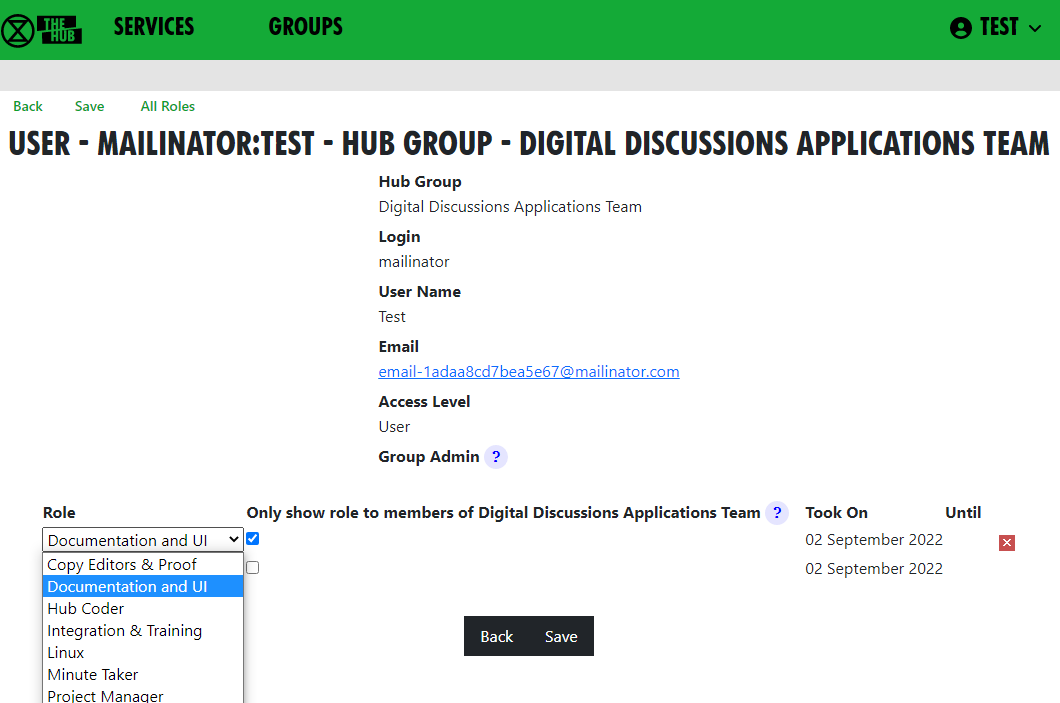 Select your role from the list your Group Admin has created, and choose whether to show it to everyone (the default), or only to other members of the group. For example External Coordinators may want to show their role to everyone, and
Action Planners may want to remain a little more anonymous.
Select your role from the list your Group Admin has created, and choose whether to show it to everyone (the default), or only to other members of the group. For example External Coordinators may want to show their role to everyone, and
Action Planners may want to remain a little more anonymous.
You cannot add yourself to Core Roles (shown in blue on the screen and diagram) or Linked Roles (shown with a yellow border) - only your Group Admins can add people to these.
Your group can ask your Group Admin to create new roles, or edit the mandates of existing ones.
Leaving a group
If you want to leave a group, go to the group here, click on Leave Hub Group. That will remove you from the Hub Group, and from all the private areas belonging to that Hub Group. It will not remove you from public channels and forums, but you can do this yourself in Mattermost and Forums respectively, if you wish.
Seeing all your Roles in all groups
Click on My Roles in the grey menu at the top to see a list of all the roles you hold. It has a History option to show you all the changes to your role holding.
Stepping back from roles
Click on My Roles in the grey menu at the top to see a list of all the roles you hold. Then click on Step Back From Roles.
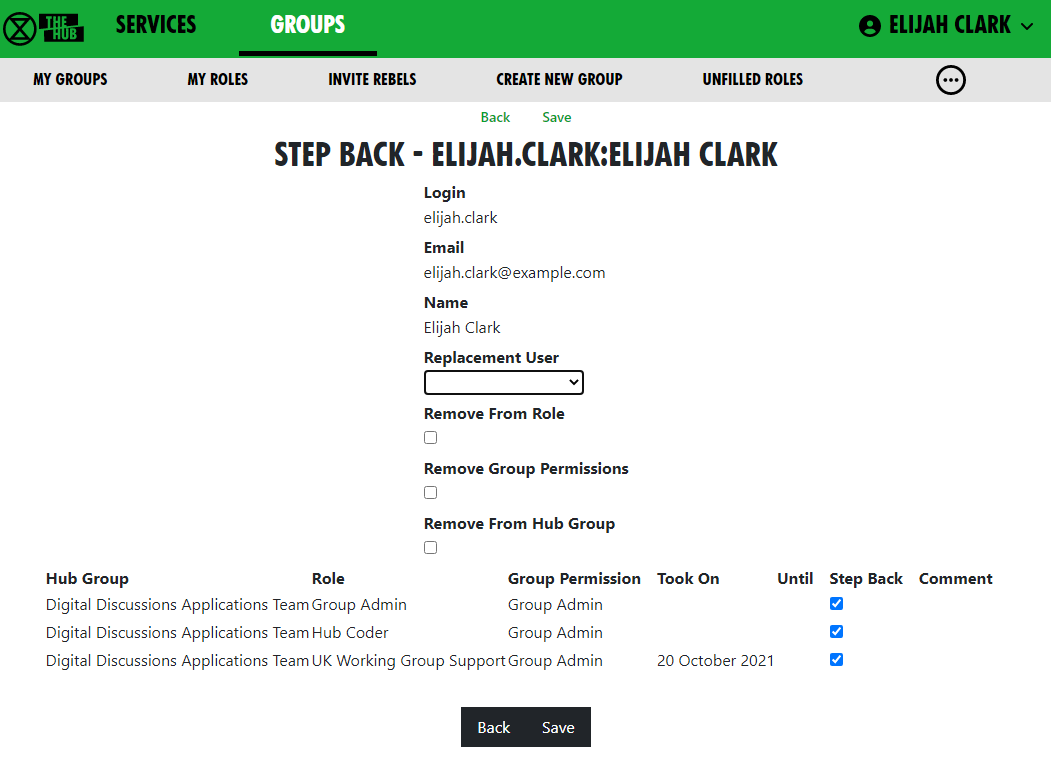 This shows all your roles, all with Step Back ticked. and gives you these options:
This shows all your roles, all with Step Back ticked. and gives you these options:
- Assign another user to the ticked roles
- Remove yourself from the ticked roles
- Leave the groups the ticked roles are in.
- Make sure only those roles you are stepping back from are ticked - untick the ones you want to remain in.
- If someone else has agreed to take on these roles, select that person from the dropdown.
- If you want to remain in the role for a while (e.g. to train your replacement), leave Remove from Role unticked. But if you want to step back right away, tick it.
- If you have Inviter or Group Admin permission in any of these groups, tick Remove Group Permissions to remove those permissions.
- If you are stepping back from the groups altogether, tick Remove From Hub Group
Then click Save.
Your menu
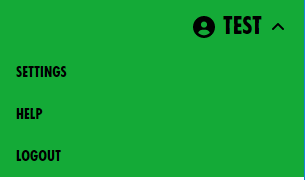 Click on your user name to see your menu.
Click on your user name to see your menu.
Settings
This form lets you change your name and secret codeword. This just changes the information we hold on the Hub, not on the other services. Also lets you change who can see your email and/or phone number.
There is an edit button next to Login and Email. Clicking the button takes you to a form to change your login or email. These forms require you to enter your Mattermost password (as the Hub does not store your password, and it needs it to update your username or email address on Mattermost). A few people have different Hub and Mattermost passwords -- if that is the case, you will be asked to confirm they are different.
Once you save the form, the Hub will try to change everything on all the services (Hub, Mattermost, UK Forums and UK Cloud) to be the same.
If it is unable to do so, it will tell you which ones went wrong. The main reasons this may happen are:
-
You put in the wrong Mattermost password
-
Someone else is already using the login name or email you chose (Mattermost is global, so there are lots of users on Mattermost who aren't on the Hub).
If any errors occur, you can go back to My Settings, and try to change to something different.
Note: It is not possible to change a username on UK Cloud. So the Hub deletes your old user record, and creates a new one, joined to the same groups as the old one. This is usually fine, but if someone shared something with you by name, or you created personal calendars, decks or forms, they will be lost.
Change my password
Reached from Settings. Lets you change your password on the Hub only. To change your password on the other services, you need to use the facilities on each other service.
Deactivate me
Reached from Settings. Lets you deactivate your login - e.g. if you have been arrested and/or your phone has been siezed. You won't be able to login to the Hub, Forums, Cloud or Mattermost until you get your Group Admin to reactivate you.
Logout
Lets you log off, e.g. if you are using a shared computer, and don't want the next person to be able to access your Hub account. NB this only logs you out of the Hub, not from the individual services which you may have open in other tabs or apps.

